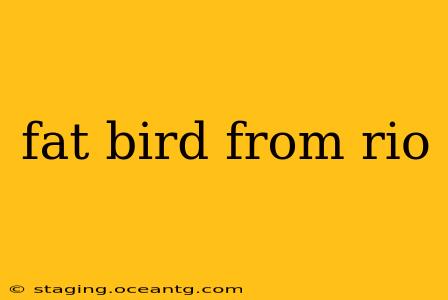The phrase "fat bird from Rio" immediately conjures up an image of a vibrant, plump avian resident of Brazil's iconic city. While no single bird is definitively known by this colloquial name, the most likely candidate, and the one that likely inspired the phrase, is the hyacinth macaw (Anodorhynchus hyacinthinus). This magnificent creature is not just "fat," but also exceptionally large, boasting stunning cobalt blue plumage and a powerful beak. Let's delve into what makes this bird so captivating and explore some frequently asked questions surrounding it.
What is a Hyacinth Macaw?
The hyacinth macaw is the largest species of parrot in the world, with an impressive wingspan reaching up to 4 feet. Their striking blue feathers, coupled with their powerful, charcoal-grey beak, make them instantly recognizable. They are native to the Pantanal wetlands and Cerrado savannas of central-western Brazil, Bolivia, and Paraguay, often found near water sources. Their diet primarily consists of nuts, seeds, fruits, and other vegetation.
How big is a Hyacinth Macaw?
As mentioned, these birds are giants among parrots. Adults typically measure around 3.5 feet (1 meter) in length, from the tip of their beak to the end of their tail. Their weight can vary, but they are significantly larger than other macaw species, leading to the perception of them being "fat." However, this is simply due to their considerable size and robust build.
What do Hyacinth Macaws eat?
Their diet is surprisingly specialized for such a large bird. Hyacinth macaws rely heavily on the nuts of the acuri palm tree (Attalea speciosa), which requires a powerful beak to crack open. They also supplement their diet with other nuts, seeds, fruits, and even some insects and larvae. Their strong beaks are crucial for their survival and reflect their dietary needs.
Are Hyacinth Macaws endangered?
Sadly, yes. Hyacinth macaws are currently listed as Vulnerable by the IUCN (International Union for Conservation of Nature). Habitat loss due to deforestation and agriculture is a major threat, along with illegal capture for the pet trade. Conservation efforts are underway to protect their dwindling populations and their natural habitats, but much work remains to be done.
Where can I see Hyacinth Macaws?
While you might not stumble upon them casually strolling through Rio de Janeiro, you can see these birds in various wildlife reserves and sanctuaries throughout their native range in Brazil, Bolivia, and Paraguay. Many zoos worldwide also participate in breeding programs to help ensure the survival of this remarkable species. Check with local wildlife organizations and zoos for specific viewing opportunities.
What is the lifespan of a Hyacinth Macaw?
Hyacinth macaws are known for their longevity, with a lifespan in the wild typically ranging between 40 and 60 years. In captivity, with proper care, they can even live longer. This demonstrates their resilience and further emphasizes the importance of conservation efforts to protect them.
What are the conservation efforts for Hyacinth Macaws?
Various organizations are dedicated to protecting Hyacinth Macaws and their habitats. These efforts include habitat preservation, anti-poaching initiatives, and captive breeding programs to boost the wild population. Supporting these organizations and educating others about the importance of conservation are vital steps in ensuring the survival of this magnificent bird.
The "fat bird from Rio" may not be a formal name, but it perfectly captures the essence of the hyacinth macaw's impressive size and vibrant presence. Learning more about these incredible creatures underscores the need for continuous conservation efforts to preserve these magnificent birds for future generations.
